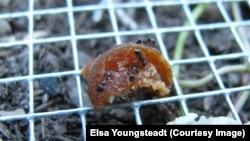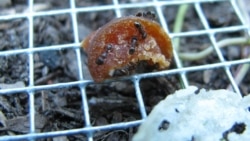Ants can help clean up city streets, according to a new study.
And that’s good news, because billions of dollars are spent each year to pick up litter that is carelessly thrown away and ends up on our urban landscape. Half of that litter is discarded food.
Until now, scientists didn’t know how much garbage a tiny ant could eat.
Insect ecologist Elsa Youngsteadt led the study to find out. She and a team of researchers from North Carolina State University conducted a controlled experiment in New York City parks and on the grassy street medians along 150 blocks. At each site, they laid out two tempting banquets of common junk food — hot dogs, potato chips and cookies.
“One [was] set in a cage where only ants and other arthropods and tiny animals could get to it, and then one outside of the cage where any hungry animal could have at it, including ants as well as rats or mice or pigeons,” she said.
The team expected that the ants that lived in parks would eat more over the 24-hour period of the study than their counterparts that lived next to the street.
“But we found the opposite,” Youngsteadt said. “In medians, about two to three times more food got eaten by the arthropods than it did in parks. And it looks likely that it is most likely this one species of ant — it is called 'pavement ants' — that were doing a lot of the eating.”
The researchers are not exactly sure why, but pavement ants are specially adapted to life on city median strips. Youngsteadt calculated that in one year, the insects in this stretch of New York could eat the equivalent of 60,000 hot dogs, 200,000 cookies and 600,000 potato chips.
The experiment also found that arthropods are competing for the same food as rats and pigeons, and that helps limit the population of those urban pests.
“That is an important job that they are out there doing that we never really measured or necessarily thought of as a benefit before,” Youngsteadt said. “You know, [when] an ant shows up in your kitchen, you do not really like it, but they are doing that same job out in the city outdoors, making it cleaner.”
The study pointed to the importance of maintaining a variety of greenspaces in urban areas.
Youngsteadt added that the garbage-eating insects can be pretty tough bugs. Her work indicated that not even the brackish floodwaters from Hurricane Sandy in the New York City region in 2012 killed them or curbed their appetites.










